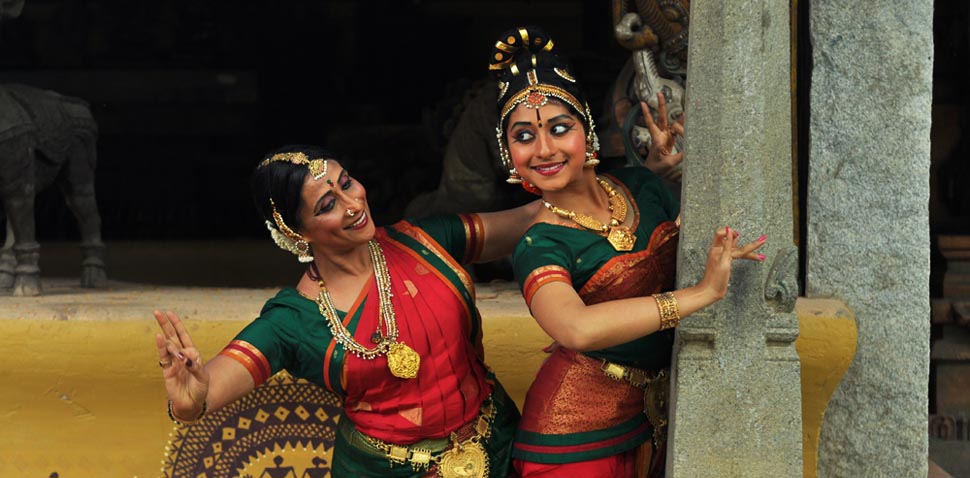
Vyjayanthi Kashi
Dancer par excellence Vyjayanthi Kashi’s career spans over an impressive spectrum of performance, choreography, teaching acting and research. Her works has been featured in several International festivals including the Oriental Dance Festival Germany, Festival of India in Africa, India Film Festival in Malaga, Olympic Festival in Italy, First International Kuchipudi Dance Convention at California the dance and music festival in US, International Dance & Music Festival in Egypt, Malta, Tunisia, Karmiel Dance Festival in Israel and many more.
She serves on the Arts and Cultural Committee of the Ministry of Tourism and Cultural, Government of India. Founder of the Shambhavi School of Dance she has trained many dance aspirants round the world. She has been honored with several awards including Kala Shree, Zee Astitva, Araya Bhatta and Vocational Excellence Awards. She was recently awarded with the Central Sangeeth Natak Academy Puraskar, the Rajyotsava award 2010 for her contribution to Kuchipudi and more. She has recently been appointed as the Chairman of the Karnataka Sangeetha Nritya Academy.
Ms. Prateeksha Kashi
As a child, it is said that Prateeksha sang and danced the whole of the dance drama AMBE from Mahabharata when she was just three years young. Ever since, she is being trained in Kuchipudi under the guidance of her mother and Guru Smt. Vyjayanthi Kashi. At the age of thirteen, Prateeksha topped the state in the Kuchipudi dance exams with a distinction. Prateeksha has presented solo performances in many prestigious festivals in India and abroad to mention a few , Festival of Dance – Los Angelis, Dance Festival – New York, Milap Festival – U K and more…
She is a recipient of “Nalanda Nritya
Nipuna”, an award instituted by the Nalanda Dance Research Centre
and also a recipient of the prestigious scholarship from the Ministry
of Culture, Govt of India. Prateeksha also has the credit of being featured
in many dance productions for the television media and is a graded artist
of the Doordarshan Kendra. She is now dancing and playing prominent roles
in almost all the dance dramas with her seniors for many national dance
festivals.
This compilation is an attempt to map the evolution of the ‘Kuchipudi’ dance form which originally was performed only as a dance drama to its current form where the solo format of presentation also has gained in popularity. The journey of the accompanying music & choreography as they changed with the evolution is also captured.
1) Salutations to Balatripurasundari
The presentation begins with a salutation song to Kuchupudi Vani also
known as Balatripurasundari the goddess of the kuchipudi village. This
composition by Nritya Vachaspati Guru Vedantam Parvateesam heaps praises
on Kuchupudi Vani and the richness of the art form. She is praised for
her mellifluous vocals, chatur-vidha abhinaya & navarasa skills.
2) Shrusthi:
Shrushti or the emergence of the universe resulted from pranavanadham
, the om or omkara. The universe being made up of the Pancha Bhutas –
aakasha, vayu, agni, jalam and pritvi whose combination gives way for
life or jeevothpattas . Life after undergoing different stages of evolution
culminates into the human form filled with all the worldly desires or
kama, Resulting in – Janma Janmantharam, Karma Karmaantharam { Kalaya
Thasmai Namaha} . Vyjayanthi Kashi has weaved the beejaksharas Ham, Yam,
Ram, Lam and Vam corresponding to the five elements into the jatti format.
3) Tarangam:
This is a special number in Kuchipudi. The song accompanying this number
is from the well-known “Krishnaleela Tarangini”, a text that
recounts the life and events of Lord Krishna by Saint Narayan Theertha
who uses various literary and musical forms such as songs, prose passages,
slokas & dwipadis.
Vyjayanthi Kashi has knit in the various literary aspects of this musical
opera into this tarangam “Pahi Pahi Pahi…”along with
the melody of the swaras and tanams . A special element of skill is involved
here. The dancers use various pada karmas and dance on the rim of a brass
plate. The brass plate is the symbol of Karmakanda: one's field of activity.
And the dancer is a Karma Yogi: highly disciplined with the knowledge
of some footwork. Dancing on the rim indicates the human possibilities
to reach beyond the limits
Raga Amruta Varshini, tala Adi
4) Thillana:
The concluding presentation is Thillana. It is a salutation to the Sun
God symbolizing that the end is the beginning. Choreographed to rhythmic
intricacies and choreographic patterns, this thillana is a tribute to
the fact that a performance never truly concludes but like the rising
of the sun it is the beginning of many more to come.
